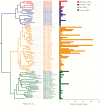Prevalence and Epidemiologic Profile of Oral Infection with Alpha, Beta, and Gamma Papillomaviruses in an Asian Chinese Population
- PMID: 29982800
- PMCID: PMC6049037
- DOI: 10.1093/infdis/jiy160
Prevalence and Epidemiologic Profile of Oral Infection with Alpha, Beta, and Gamma Papillomaviruses in an Asian Chinese Population
Abstract
Background: Knowledge of the prevalence of and risk factors for oral human papillomavirus (HPV) infection, especially cutaneous types, is limited.
Methods: A population-based study using next-generation sequencing consecutively recruited asymptomatic individuals aged 18-64 years from a proportional sampling of the general population of Hong Kong, according to age groups, gender, and regions of residence. We examined associations of alpha-, beta-, and gamma-HPVs from oral rinse samples with participants' sociodemographics by logistic regression models.
Results: The prevalence of oral HPV infection among 1426 ethnic Chinese was 15.5% (95% confidence interval [CI], 13.7%-17.5%), 2.5% (95% CI, 1.8%-3.5%), 11.9% (95% CI, 10.3%-13.6%), and 2.9% (95% CI, 2.1%-3.9%) for any type, alpha-, beta-, and gamma-HPV, respectively. Prevalence of any high-risk HPV was 0.8% (95% CI, 0.4%-1.4%), and that of HPV-16 was 0.4% (95% CI, 0.2%-0.8%). HPV-8 and HPV-98 were the most common beta types detected, while HPV-4 and HPV-SD2R were the most common gamma types. Prevalence of alpha- and beta/gamma-HPV infection showed a similar pattern of increase with age, and was higher in men than women. Smoking, drinking, oral sex, and more sexual partners were associated with alpha-HPV. Teeth brushing before sleep was protective for beta/gamma-HPVs.
Discussion: The epidemiologic factors associated with oral infection with alpha-HPVs are different from those of beta/gamma-HPVs, suggesting different modes of acquisition and persistence.
Figures



References
-
- World Health Organization International Agency for Research on Cancer. IARC monographs on the evaluation of carcinogenic risks to humans. Human Papillomaviruses. Vol 90 Lyon: IARC, 2007.
-
- Chaturvedi AK, Engels EA, Anderson WF, Gillison ML. Incidence trends for human papillomavirus-related and -unrelated oral squamous cell carcinomas in the United States. J Clin Oncol 2008; 26:612–9. - PubMed
-
- Huang H, Zhang B, Chen W et al. . Human papillomavirus infection and prognostic predictors in patients with oropharyngeal squamous cell carcinoma. Asian Pac J Cancer Prev 2012; 13:891–6. - PubMed
Publication types
MeSH terms
LinkOut - more resources
Full Text Sources
Other Literature Sources
Medical

